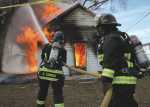Inferno...

Once it got started, there was no going back. Mark Moore thrust the lit flare through an open window, igniting the fuel in a room that once served as a kitchen.
At the same time, the outside air caused the front door of the house to repeatedly open and slam shut.
It almost seemed that the home was being defiant despite the fact that its fate was already sealed.
As Moore moved to the next opening in the house, it took less than two minutes for the fire to roar out of control.
A tower of flame spilled out of the window behind him as he set the next fire in an adjacent opening.
Stepping down a few more feet, the firefighter set more debris on fire before he triggered another blaze and then another.
The fire raged on...
The mood in the room quickly turned to business as the department's senior firefighters went over the battle plan. The final strategy session spelled out the details of Saturday's exercise.
It would culminate three months of training inside a home on American Legion Boulevard that started in November and continued into January. By the time Saturday had arrived, the single-story building had served as a hands-on training site for 24 different scenarios.
Some of the training involved setting small-scale fires inside the structure. Others involved "cold fire" situations in which smoke generators were used to replicate conditions inside the structure.
There was no question that Saturday's exercise would be the last one inside that house. This time, they planned to raze the structure to its foundation.
Rolling out a map of the home and surrounding neighborhood, firefighter Chuck Van Meer went step by step through the plan. Everything focused on details, ensuring everything went according to plan.
Once they arrived on scene, Van Meer expected it would take at least 45 minutes to get the house ready to burn. The goal was to direct the flow of the flames, starting on the east side of the house and causing them to move toward to west.
Referring to the map once again, he showed the places where crews would cut holes in the roof and walls on the eastern side of the structure before the first fire was set. The goal was to keep the walls on the west side of the house standing as long as possible.
"Falling this house will be like falling a tree," said Mark Moore, a captain with the fire department. "It's well thought out to be a controlled fire."
Knowing they would let the house burn to the ground, the purpose of the exercise focused on containing the flames to the structure itself. That wasn't going to be easy since there were at least two large trees next to the home with people living in apartments and houses nearby, Van Meer said.
Nothing was left to chance -- not even the weather. Fire chief Alan Bermensolo reviewed the forecast that morning, which included the possibility of light winds later that morning.
However, the forecasts indicated that the fire would already start dying down by the time these winds would pose a threat.
One of their biggest concerns dealt with overhead power lines that stretched along the street in front of the house with another set of live power lines located on the west side of the house. In addition to keeping their eye on the flames, the crews would need to pay close attention to those lines and keep from streaming water near them just in case.
Their other concern focused on bystanders standing across American Legion Boulevard or driving by as the house burned. They were particularly worried that drivers would pay more attention to the fire versus watching out for people or other vehicle traffic.
Plans were also in place to have crews and trucks on standby in case an actual fire began elsewhere in town that morning. Meanwhile, they wanted to ensure those living downwind were also looked after during and after the fire since they would be dealing with all the smoke and flying debris.
Satisfied with the plan, the senior officers met with the rest of the department's firefighters to once again review the plan. During that briefing, Moore said the training to date had remained free of any injuries, adding that he wanted to continue that safety record that morning.
"We need things to go smooth," Van Meer added. There was no room for firefighters to let down their guard and get complacent.
There was little fanfare as the department's fire vehicles drove to the scene of the scheduled fire. Some of the crews rolled out the hoses and charged them with water while others peeled away openings in the roof or cut additional holes in the wall on the east side of the building.
Everything remained on schedule as Moore set the first fire, which rapidly spread to the inside of the home.
The heat from the flames reached a blistering 1,200 degrees Fahrenheit as they rolled along the wall onto the roof. It was more than enough heat to ignite the trunk of at least one tree.
Staying focused on their containment strategy, crews regularly poured water on the trees and surrounding ground. At the same time, they continued to spray the roofs of surrounding structures to keep them from igniting due to the flaming debris being blown into the air.
In less than 45 minutes, there was nothing left of the main structure to indicate that it was originally a house. Only a small section of a wall on the northwest corner was still standing.
At 11:53 a.m., less than a hour after the fire started, two firefighters pushed over the last wall on the west side of the house, leaving a small portion of the front wall still standing.
The fire acted exactly as expected, said city fire marshal Brian Reed. It was a near-textbook training scenario with no problems reported.
